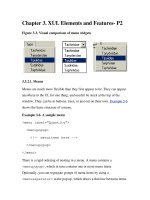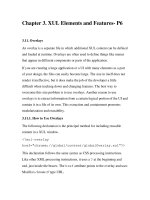Chapter 3: VLANs doc
Bạn đang xem bản rút gọn của tài liệu. Xem và tải ngay bản đầy đủ của tài liệu tại đây (2.28 MB, 59 trang )
CCNA – Semester 3
Chapter 3: VLANs
CCNA Exploration 4.0
2
Objectives
• Explain the role of VLANs in a network
• Explain the role of trunking VLANs in a network
• Configure VLANs on the switches in a network
topology
• Troubleshoot the common software or hardware
configuration problems associated with VLANs on
switches in a network topology
3
Introducing VLANs
4
Introducing VLANs
5
What is a VLAN?
6
What is a VLAN?
7
Benefits of a VLAN
8
Introducing VLANs
9
Types of VLANs
• Today there is essentially one way of implementing VLANs -
port-based VLANs. A port-based VLAN is associated with a
port called an access VLAN.
• However in the network there are a number of terms for
VLANs. Some terms define the type of network traffic they
carry and others define a specific function a VLAN performs.
VLAN Types:
• Data VLAN:
– Is a VLAN that is configured to carry only user-generated
traffic
– A VLAN could carry voice-based traffic or traffic used to
manage the switch, but this traffic would not be part of a
data VLAN.
– Sometimes referred to as a user VLAN
10
Types of VLANs
• Default VLAN:
– All switch ports become a member of the default VLAN after
the initial boot up of the switch.
– The default VLAN for Cisco switches is VLAN 1, you cannot
rename it and you can not delete it.
– Layer 2 control traffic, such as CDP and spanning tree
protocol (STP) traffic, will always be associated with VLAN 1
- this cannot be changed.
– It is a security best practice to change the default VLAN to a
VLAN other than VLAN 1
• Note: Some network administrators use the term "default VLAN" to mean a
VLAN other than VLAN 1 defined by the network administrator as the VLAN
that all ports are assigned to when they are not in use. In this case, the only
role that VLAN 1 plays is that of handling Layer 2 control traffic for the
network.
11
Types of VLANs
• Native VLAN:
– A native VLAN is assigned to an 802.1Q trunk port. An
802.1Q trunk port supports traffic coming from many
VLANs (tagged traffic) as well as traffic that does not
come from a VLAN (untagged traffic). The 802.1Q trunk
port places untagged traffic on the native VLAN.
– Native VLANs are set out in the IEEE 802.1Q
specification to maintain backward compatibility with
untagged traffic common to legacy LAN scenarios.
– It is a best practice to use a VLAN other than VLAN 1 as
the native VLAN.
12
Types of VLANs
• Management VLAN
– A management VLAN is any VLAN you configure to
access the management capabilities of a switch.
– VLAN 1 would serve as the management VLAN if you did
not proactively define a unique VLAN to serve as the
management VLAN.
– You assign the management VLAN an IP address and
subnet mask. A switch can be managed via HTTP,
Telnet, SSH, or SNMP.
Since the out-of-the-box configuration of a Cisco switch has
VLAN 1 as the default VLAN, you see that VLAN 1 would be
a bad choice as the management VLAN.
13
Types of VLANs
• Voice VLANs
VoIP traffic requires:
– Assured bandwidth to ensure voice quality
– Transmission priority over other types of network traffic
– Ability to be routed around congested areas on the
network
– Delay of less than 150 milliseconds (ms) across the
network
A Cisco Phone is a Switch: contains an integrated three-port
10/100 switch:
– Port 1 connects to the switch or other voice-over-IP
(VoIP) device.
– Port 2 is an internal 10/100 interface that carries the IP
phone traffic.
– Port 3 (access port) connects to a PC or other device.
14
Types of VLANs
• Voice VLAN
15
Types of VLANs
• Cisco IP Phone
16
Network Traffic Types
• Network Management and Control Traffic
17
Network Traffic Types
• IP Telephony
18
Network Traffic Types
• IP Multicast
19
Network Traffic Types
• Normal Data
20
Switch Port Membership Modes
• Switch ports are Layer 2-only interfaces associated with a
physical port.
A port can be configured to support these VLAN types:
• Static VLAN - Ports on a switch are manually assigned to a
VLAN.
• Dynamic VLAN - This mode is not widely used in production
networks and is not explored in this course. However, it is
useful to know what a dynamic VLAN is. A dynamic port
VLAN membership is configured using a special server
called a VLAN Membership Policy Server (VMPS), based on
the source MAC address of the device connected to the port.
• Voice VLAN - A port is configured to be in voice mode so
that it can support an IP phone attached to it. Before you
configure a voice VLAN on the port, you need to first
configure a VLAN for voice and a VLAN for data.
21
Switch Port Membership Modes
22
Switch Port Membership Modes
• Voice Mode configuration
23
Controlling Broadcast Domains with VLANs
• Without VLANs: In normal operation, when a switch
receives a broadcast frame on one of its ports, it forwards
the frame out all other ports on the switch.
24
Controlling Broadcast Domains with VLANs
• With VLANs: the broadcast frame arrives at the only other
computer in the network configured on the same VLAN
25
Controlling Broadcast Domains with
Switches and Routers
Intra-VLAN Communication
• PC1 want to communicate with PC4.









